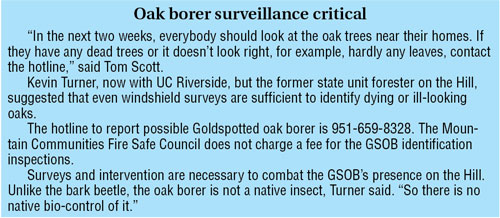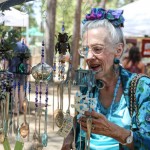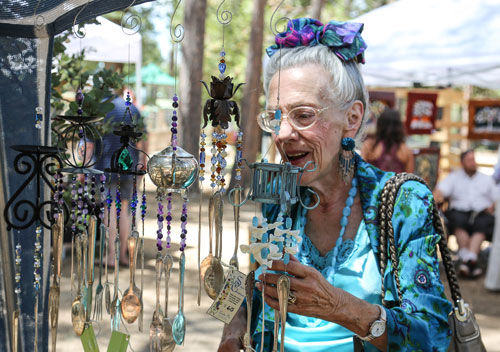
Photo by J.P. Crumrine
The danger of losing all of the Hill’s black oaks has not disappeared, and the next two weeks may be the most critical since the Goldspotted oak borer’s presence was discovered here in 2012. The GSOB will be emerging from oaks in June and ready to find new homes, consequently, it is the most critical time of the year to identify infested trees, according to Kevin Turner, GSOB coordinator for the University of California, Agricultural and Natural Resources in Riverside.
Since December, only four more trees have been identified as infested with GSOB. The total of confirmed infested Hill trees is now 32. That is good news. But it is not proof that the Hill will escape the devastation the GSOB has imposed in San Diego County. Keen and local vigilance of the insect’s activity is vital during the next few weeks, when it may be awakening from its winter rest.
Both Turner and his UC Riverside colleague Dr. Tom Scott, a natural resources wildlife specialist, advised members of the Mountain Communities Fire Safe Council last week to look for any oak tree without leaves. At this time in spring, oaks will be in full leaf mode. Even oaks with few, dead or wilted leaves may be harboring the GSOB.
“What happens this month is the most important for the rest of the year,” Turner stressed. “Infested trees need to be cut and ground.”
The lack of rainfall will increase the oaks’ vulnerability to the GSOB, Scott said. One tree could harbor 5,000 to 8,000 borers and if they take flight to new oaks, the result could be devastating, he warned.
Both credited the rapid-response program, which has been implemented in Idyllwild and Pine Cove, with limiting or impeding the borer’s expansion here. Actions and efforts of local volunteers has been in the forefront of the anti-GSOB work.
“It was perfect going to the Fire Safe Council, the Woodies, the Garden Club and at MAST [Mountain Area Safety Taskforce],” Turner said. “It was the perfect place to set up a protection system and involve trained volunteers to inspect trees and educate people.”
MAST agencies, in cooperation with local volunteers from these organizations, are actively surveying oaks. Using the GSOB hotline, and the rapid removal and grinding of infested trees has contributed to limiting the pest’s spread.
“[This] is the first isolated GSOB outbreak that has been discovered in initial stages and the benefit of having MAST in place ready to respond to this new community emergency,” Turner said.
However, neither Turner nor Scott was confident that the GSOB’s local invasion had been stopped or repelled.
In response to a question about using the felled oaks for firewood here, Turner and Scott confirmed it is possible under very cautious conditions. When the GSOB hatches, the larvae burrow into the tree and feed under the bark between the phloem and the sapwood.
“If you’re willing to strip the bark from the trunk, that would be great,” Scott replied. While it would save the cost of grinding the wood, the bark still has to disposed of. Also the site has to be sanitized by removing any bark remnants.
However, Turner and U.S. Forest Service District Forester Kayanna Warren did suggest that this is a good time to burn any oak firewood that has been imported to the Hill.
When asked about complacency since only 32 trees have been identified as infested, Scott stressed that when all the trees are dying, it will be too late to respond. “It’s similar to someone with high cholesterol,” he replied. “They may seem fine and unaffected, but after a stroke or coronary, it’s too late to treat it.
“If all [the oak] trees die, individuals and property owners will suffer a huge economic loss,” Scott warned. “Then it’s too late.”
Turner also recommended investigating any oak stumps for signs of GSOB since they are frequently found in oak stumps in Arizona and San Diego County.
Trials of pesticide applications have not been completed. Significant time periods are necessary in order to determine if untreated trees will succumb to GSOB. Turner added in an email, “Properly applied pesticides so far seem to be successful in protecting high-value trees.” But he stressed that trials are still incomplete.
Spraying may be useful to protect a “high-value healthy tree,” which is not infested. The cost is great for a large number of trees, so it is most efficient on trees that the land owner cannot afford to lose, according to Turner.
Following the discussion of the GSOB survey, Turner and MCFS Executive Director Edwina Scott presented certificates of appreciation to the MCFSC Woodies and volunteers from the Garden Club involved in the Goldspotted Oak Borer Early Detection Program. The certificates were from Riverside County Chair of the Board of Supervisor’s Jeff Stone and stated, “In grateful appreciation for your outstanding dedicated service to the people in your community.”
Stone has been a supporter of this program since the discovery of the first infested oak.














